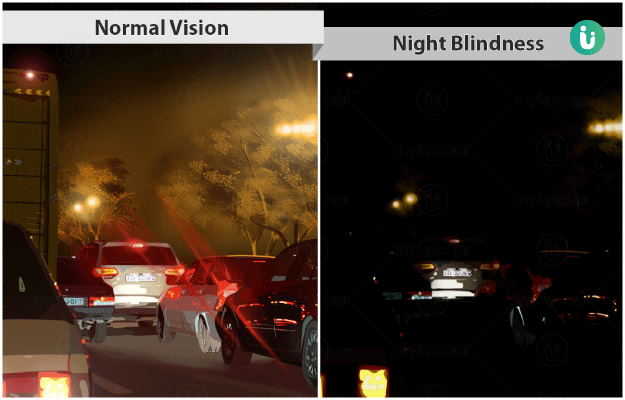What is Night Blindness?
Night blindness is a condition in which vision impairment occurs at night or in relatively low light. It is the first clinical symptom of vitamin A deficiency, and a specific and strong indicator of low serum retinol levels.
What are its main signs and symptoms?
The clinical signs and symptoms range from weak sight in dim light, difficulty while driving at night and mild eye discomfort. The earliest signs include impaired adaptation to darkness caused by low serum retinol concentrations (below 1.0 micromol/litre) and Bitot's spots. These spots are specifically seen in vitamin A deficiency and are characterised by triangular, dry, whitish, foamy appearing lesions located on the temporal (outer) side of the eye.
What are the main causes?
Inside the eye, vitamin A combines with a substance called opsin to produce rhodopsin, the photosensitive visual pigment in the rods. Our eyes have two types of light receptors, rods and cones. Rods enable vision in low light but do not give us colour vision. Cones are activated only in bright light and give us colour vision. The levels of rhodopsin can decline and this impairs their function, manifested as night blindness.
In developing countries like India, vitamin A deficiency is more rampant due to malnutrition, followed by malabsorption. A similar condition, not caused by vitamin A deficiency, is retinitis pigmentosa, a form of inherited night blindness caused by a fault in the genes.
How is it diagnosed and treated?
The diagnosis of night blindness is made by clinical findings and medical history and then confirmed by the presence of low serum vitamin A levels, Bitot’s spots and an abnormal electroretinography test showing diminished rod function.
The deficiency is treated and completely resolved by administering 2,00,000 IU of vitamin A orally, given daily for 3 days, followed by 50,000 IU for 14 days or successively followed by an additional dose after 1-4 weeks. Major dietary sources of vitamin A include plant sources, such as amaranth, carrots, bell peppers, capsicum, citrus fruits, papaya, mangoes, and other red-yellow fruits and vegetables. Animal sources, such as eggs and butter, are rich in vitamin A too. For those who are not able to tolerate medications orally, administration of intramuscular vitamin A is reserved. Since vitamin A deficiency is systemic in nature, eye drops have shown no benefits.

 Doctors for Night Blindness
Doctors for Night Blindness  OTC Medicines for Night Blindness
OTC Medicines for Night Blindness



















